The figure of the great Abai, poet and enlightener, as a person, has been interested and is interested by many artists in historically different periods of time. The figure of Abai, his life and work served as the theme of their works for many artists of Kazakhstan. With great inspiration they created his image in painting, graphics and sculpture. It’s difficult to work on his image, because only one Abai’s portrait from nature was created. Therefore, the reconstruction of the image of the great Abai – is a reproducing of vision of Abai by each artist. Picturesque and graphic works can be systematized as follows: illustrations about Abai Kunanbayev; illustrations based on the works of Abai; scenes from the life of Abai; portraits and genre paintings.
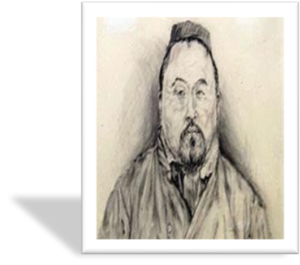 The universe and image of Abai is covered in all genres of fine art and plays an advanced role in the creation of historical paintings. The first paintings of an earlier period are the works of Russian artists. Pavel Dmitrievich Lobanovsky , exiled to Semipalatinsk in 1884 for political unreliability, depicted the only lifetime graphic Abai’s portrait (1887). The main specialty of Pavel Lobanovsky is military. Pavel Lobanovsky, who was sentenced to be deported from Rostov to Semipalatinsk (1884-1887). He met with Abai and was the only author of the Abai’s portrait made during the life of Abai.
The universe and image of Abai is covered in all genres of fine art and plays an advanced role in the creation of historical paintings. The first paintings of an earlier period are the works of Russian artists. Pavel Dmitrievich Lobanovsky , exiled to Semipalatinsk in 1884 for political unreliability, depicted the only lifetime graphic Abai’s portrait (1887). The main specialty of Pavel Lobanovsky is military. Pavel Lobanovsky, who was sentenced to be deported from Rostov to Semipalatinsk (1884-1887). He met with Abai and was the only author of the Abai’s portrait made during the life of Abai.
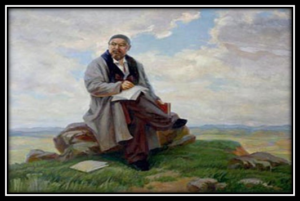 The first portrait of Abai was painted by artist M.I. Krutilnikov in the painting “Abai writes poetry” (1927). It was painted on canvas by oil paints. The subject works “Young Abai listens to the song of akyn” (1940) by the artist A. Voloshchuk and the painting “Abai and the Zhataki”( poor nomad, who did not have enough cattle for roaming)(1954) by the artist
The first portrait of Abai was painted by artist M.I. Krutilnikov in the painting “Abai writes poetry” (1927). It was painted on canvas by oil paints. The subject works “Young Abai listens to the song of akyn” (1940) by the artist A. Voloshchuk and the painting “Abai and the Zhataki”( poor nomad, who did not have enough cattle for roaming)(1954) by the artist 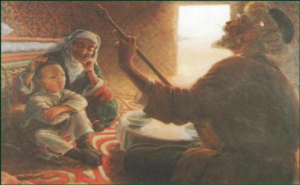 O. Kuzhelenko, made in the tradition of Russian realism, are unique. The work by A. Voloshchuk depicts young Abai, delighting by singing of the singer Baikoksha the and his grandmother Zere, who touched with love her favorite grandson. Sunlight appeared to the yurt and lit up the face of Abai. An all-consuming thirst for teaching and concentration of folk wisdom is on the Abai’s face. The painting “Abai and the Zhataki”,
O. Kuzhelenko, made in the tradition of Russian realism, are unique. The work by A. Voloshchuk depicts young Abai, delighting by singing of the singer Baikoksha the and his grandmother Zere, who touched with love her favorite grandson. Sunlight appeared to the yurt and lit up the face of Abai. An all-consuming thirst for teaching and concentration of folk wisdom is on the Abai’s face. The painting “Abai and the Zhataki”,  showed people who enthusiastic with the common conversation, reflects the close relationship and involvement of Abai to the social life of the people. The uniqueness, individuality of the poet’s life is clearly shown in the portraits of the artists A.Sh. Martova, A.M. Cherkassky, A.P. Atkninykh and A.G. Atkninykh, O.L. Ostrovsky and others.
showed people who enthusiastic with the common conversation, reflects the close relationship and involvement of Abai to the social life of the people. The uniqueness, individuality of the poet’s life is clearly shown in the portraits of the artists A.Sh. Martova, A.M. Cherkassky, A.P. Atkninykh and A.G. Atkninykh, O.L. Ostrovsky and others.
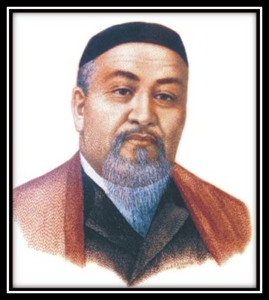 The best of all portraits of Abai are the works of artists A.L. Ostrovsky and the Atknins. The portraits reflectes Abai’s charm , a sharp insightful mind, a critical view. They presents features of the poet – critic, intellect and intelligeance of his personality and reproduces the portrait resemblance excellently, depth of psychology. All this image was achieved by the compound and original marquetry technique (wood inlay) and embroidery with embroidery. Used tastefully selected colors of yarn Gregory and Anna Atknini were able to convey the Abai’s image.
The best of all portraits of Abai are the works of artists A.L. Ostrovsky and the Atknins. The portraits reflectes Abai’s charm , a sharp insightful mind, a critical view. They presents features of the poet – critic, intellect and intelligeance of his personality and reproduces the portrait resemblance excellently, depth of psychology. All this image was achieved by the compound and original marquetry technique (wood inlay) and embroidery with embroidery. Used tastefully selected colors of yarn Gregory and Anna Atknini were able to convey the Abai’s image.
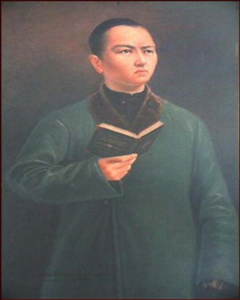 One of the first artists who turned to the image of Abai in painting was Abylkhan Kasteev. In 1945, he created a portrait of young Abai with a book in his hands. The portrait is designed in a restrained brownish-green color range. The figurative persuasiveness of the portrait has not lost its significance even now. The artist emphasized Abai’s determination, spirituality, an unprecedented first for knowledge. The portrait of Abai was painted by many Kazakhstani artists, but, basically, these were portraits of Abai in adulthood, because we only got a photograph of the poet, which depicted Abai several years before his death. A. Kasteev was able to introduce the Kazakh enlightener at a young age. In this picture Abai is very young, he is not even seventeen . He is still a student, not a teacher.
One of the first artists who turned to the image of Abai in painting was Abylkhan Kasteev. In 1945, he created a portrait of young Abai with a book in his hands. The portrait is designed in a restrained brownish-green color range. The figurative persuasiveness of the portrait has not lost its significance even now. The artist emphasized Abai’s determination, spirituality, an unprecedented first for knowledge. The portrait of Abai was painted by many Kazakhstani artists, but, basically, these were portraits of Abai in adulthood, because we only got a photograph of the poet, which depicted Abai several years before his death. A. Kasteev was able to introduce the Kazakh enlightener at a young age. In this picture Abai is very young, he is not even seventeen . He is still a student, not a teacher.
His gaze is fixed at the distance, an open book is in his hands. He has youthful tender skin, puffy ruddy face, red lips. However, a high clean forehead, a clear inquisitive gaze, looking somewhere outside, tightly pressed lips, a solid line of eyebrows – all this indicates him as a great thinker. In his view, there is something from the great thinkers of the East – Ibn Sina (Avicenna), Omar Khayyam. Abai was painted in a black shirt, green velvet camisole, a black skullcap was on his head. There is nothing superfluous in clothing; it demonstrates the moderation and neatness of the owner. A book for Abai from a young age was a best friend, he reached out for knowledge. The author used muted colors: dark green, gray, black, pale pink. The artist showed the mood of the hero, his thoughtfulness, contemplation.
 The artist did not choose a half-length portrait (one of the most common forms of composition in portrait ), he depicted image of Abai to knees. This composition contributes to the impression of the monumentality of the portrait and it was conducive the significance of the image of the poet. A. Kasteev showed the great enlightening role of Abai for the Kazakh people. A distinctive feature of A. Kasteev’s genre paintings is the connection of a person with the environment, with the landscape. In this way in the painting “Abai by the Yurt” Abai Kunanbayev is depicted with a book by A.S. Pushkin (his faithful teacher) and on the background of his native village, the immense Kazakh steppe.
The artist did not choose a half-length portrait (one of the most common forms of composition in portrait ), he depicted image of Abai to knees. This composition contributes to the impression of the monumentality of the portrait and it was conducive the significance of the image of the poet. A. Kasteev showed the great enlightening role of Abai for the Kazakh people. A distinctive feature of A. Kasteev’s genre paintings is the connection of a person with the environment, with the landscape. In this way in the painting “Abai by the Yurt” Abai Kunanbayev is depicted with a book by A.S. Pushkin (his faithful teacher) and on the background of his native village, the immense Kazakh steppe.
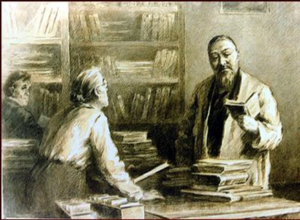 One of the first visitors to the library was the Kazakh enlightener Abai Kunanbaev. He used encyclopedias, dictionaries, reference books. But most of all he was interested in Russian literature. Abai got acquainted with the works of Russian writers, he translated Krylov’s fables, tales of Saltykov-Shchedrin, works of A.S. Pushkin, L.N. Tolstoy, he got acquainted with foreign literature:works of Byron, Shakespeare, Schiller, Goethe through translations of M.Yu. Lermontov. All these books had a huge effect upon Abai. In the famous painting “Abai in the library” (1954)a Soviet painter Leonid Pavlovich Leontiev depicted Abai in a conversation with a librarian. In the picture, the artist was able to portrait the image of Abai with great wisdom, tried to point to his mind and will.
One of the first visitors to the library was the Kazakh enlightener Abai Kunanbaev. He used encyclopedias, dictionaries, reference books. But most of all he was interested in Russian literature. Abai got acquainted with the works of Russian writers, he translated Krylov’s fables, tales of Saltykov-Shchedrin, works of A.S. Pushkin, L.N. Tolstoy, he got acquainted with foreign literature:works of Byron, Shakespeare, Schiller, Goethe through translations of M.Yu. Lermontov. All these books had a huge effect upon Abai. In the famous painting “Abai in the library” (1954)a Soviet painter Leonid Pavlovich Leontiev depicted Abai in a conversation with a librarian. In the picture, the artist was able to portrait the image of Abai with great wisdom, tried to point to his mind and will.
A pleiad of graphic artists, rethinking the work of Abai, created book illustrations for his works. Among them is a collection of works by easel lithography and etchings by Evgeny Mikhailovich Sidorkin. Evgeny Sidorkin (1930 – 1982) is a Soviet graphic artist, Honored Artist of the Kazakh SSR (1965), laureate of the State Prize of the Kazakh SSR named after Chokan Valikhanov (1979), People’s artist of the Kazakh SSR (1981).
All together, the Sidorkin’s illustrations from Auzov’s novel “ The way of Abai” look like an united large-scale canvas, and it is combined by three portraits – “Mukhtar Auezov”, “Abai-aga”, “Abai-poet”. Here the plot, as it were, is viewed through a double prism – through the perception of it by Abai and the author of the novel. The main themes of Sidorkin’s works are the psychology of images and traits of the heroes of M. Auezov’s historical novel “The Way of Abai”, national games and the Kazakh epic. They allow to create psychologically nuanced images.
In the graphic sheets “The Seasons”by M. Kisamedinov, the poetic and artistic world of Abai, collected together into a generalized image of mother Earth is revealed. As a whole the composition of the each sheet makes up a peculiar graphic story about the aesthetic ideal of the Kazakh people. In the genre, quite ordinary motives Kisamedinov achieves great generalization. The sheet “Winter” is the most expressive in its plastic form. In a dynamic system of engraving, the plot (the battle of shepherds with wolves) serves as an important material from which the truth about the all-conquering power of man is extracted. In engravings of Kisamedinov depth in space, light have a great importance.
Kisamedinov Makym Mustakovich (1939-1982) – artist, member of the Union of Artists of Kazakhstan. Makym Kisamedinov belongs to the group of “sixties” – artists who worked in the late 60s and early 70s of the last century. The first creative work of Kisamedinov was the design and illustration of the jubilee edition of Abai Kunanbayev’s poems in 2 volumes.
Famous Kazakh painter Kamil Shayakhmetov (1928 – 1995) take up to the image of young Abai. With special warmth, he portrayed a boy Abai studying in a Russian school. With particular conviction in a realistic manner, Kanafiy Timirbolatovich Telzhanov (1927 – 2013) – a classic of national Kazakh painting, was reflected the personality of Abai. The painter monumentalizes the image of Abai, thereby combining the virtues of easel paintings and monumental art.
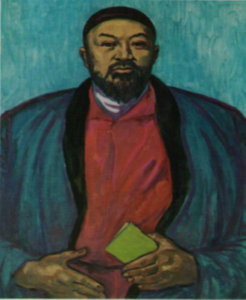 In 1977, artists K. Shayakhmetov, N. Nurmukhammedov depict events of history, of Abai’s father, Kunanbay Uskenbaev reign in the Karazhartas gorge. The painting by K. Shayakhmetov “The Life of Kodar” is deeply tragic. In the picture was depicted the scene of the Day of Judgement , the mourners, and the people who sentenced the condemnation of the atheist old Kodar. Nurmukhammedov’s painting “Abai at the Tomb of Kodar” is a philosophical comprehension of the time and the poet experiences a feeling of deep sadness.
In 1977, artists K. Shayakhmetov, N. Nurmukhammedov depict events of history, of Abai’s father, Kunanbay Uskenbaev reign in the Karazhartas gorge. The painting by K. Shayakhmetov “The Life of Kodar” is deeply tragic. In the picture was depicted the scene of the Day of Judgement , the mourners, and the people who sentenced the condemnation of the atheist old Kodar. Nurmukhammedov’s painting “Abai at the Tomb of Kodar” is a philosophical comprehension of the time and the poet experiences a feeling of deep sadness.
Nurmukhammedov Nagim-Bek (1924-1986) is a People’s Artist of the Republic of Kazakhstan. With the same interest and enthusiasm, he paints large historical canvases, and paintings reflecting the expressive moments of modern life, and official and psychological portraits and paints landscapes. His portrait of Abai seems dignified, full of dignity.
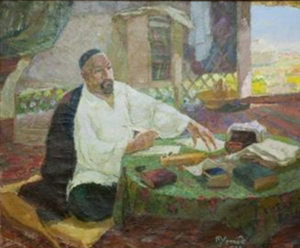 The works of the honored artist of the Kazakh SSR, graphic artist Konstantin Yakovlevich Baranov attract attention with their unique originality. Portraits of the classics of Kazakh poetry – Abai and Dzhambul – are also made in the technique of lithography. In these portraits sharpness and a realy creative approach to business of the artist was showed in full measure. Although there were, of course, considerable difficulties. Nevertheless, Baranov was able to convey the character and significance of the creative personality of Abai in the portraits.
The works of the honored artist of the Kazakh SSR, graphic artist Konstantin Yakovlevich Baranov attract attention with their unique originality. Portraits of the classics of Kazakh poetry – Abai and Dzhambul – are also made in the technique of lithography. In these portraits sharpness and a realy creative approach to business of the artist was showed in full measure. Although there were, of course, considerable difficulties. Nevertheless, Baranov was able to convey the character and significance of the creative personality of Abai in the portraits.
“The theme of Abai”, his image was depicted in the works by Bucky Idrisovich Urmanche (1897-1990). He is the People’s artist of the Russian Federation, a honored Artist of the Kazakh SSR, winner of the Gabdulla Tukai Prize. In Kazakhstan, he worked and created a portrait gallery of figures of Kazakh history and culture in 1941-1956. In Kazakhstan, he painted “Abai in a Yurt” (1946) devoted to Abai’s perso nality.
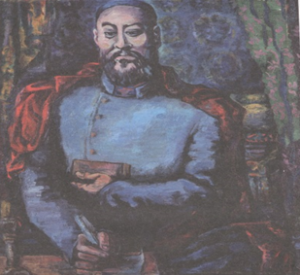 The combination of interior and landscape is becoming a favorite technique in Urmanche’s portraits.Sunlight percolates through the opened curtain to the yurt, allowing the artist to use various lighting effects. The motif of open door is often used by Bucky Urmanche. He draws a series of portraits of shepherds (1949), using precisely this scheme. Using the favorite motif of European portraiture of the 15th century, he enriched the composition with new meanings and gave a special solemnity to this work.
The combination of interior and landscape is becoming a favorite technique in Urmanche’s portraits.Sunlight percolates through the opened curtain to the yurt, allowing the artist to use various lighting effects. The motif of open door is often used by Bucky Urmanche. He draws a series of portraits of shepherds (1949), using precisely this scheme. Using the favorite motif of European portraiture of the 15th century, he enriched the composition with new meanings and gave a special solemnity to this work.
Using the technique of etching and linocut Isatay Isabaev created a series of works based on the works of Abai. His the etching “Abai” is remarkable (a sheet from the series “Abai”, 1976). The artist shows the image of Abai in an closed connection with the people, with the earth, in unity with nature. The unifying center of the two-part composition is the idol, meaning the spirit of the forbears. It seems that the artist wanted to show Abai, knowing the wisdom of his forbears, the land, folk traditions. Isabaev Isatai Nuryshevich (1936-2007) is artist, member of the Union of Artists of the USSR (since 1966), possessor of the diploma “Behzad” (Ashkhabad, 1991), laureate of Prize “Tarlan” (2005), Honored Artist of the Kazakh SSR (1988). The artist was able to depict the image of Abai with a deep understanding of words and his imagination.
Artists Raimkul Yesirkeev, Seitmakhan Kalmakhanov, Andrey Osipenko depict Abai as elevated, concentrated, serious, deeply thoughtful man. In their pictures they often depicted image of Abai on the background of the steppe, with connection with the land, with his homeland, which became part of his life and poetry.
One of the first works dedicated to the Kazakh enlightener and poet was the painting by Raimkul Yesirkeev, one of the oldest artists in Kazakhstan (1921-1980). R. Esirkeev created a generalized, sublime image of Abai (1968). He depicted Abai wearing a beshmet over his shoulders, with a book in his hands, on the background of his native mountains and the steppe. Used the impression of movement of the picture, the artist was able to reveal Abai’s rebellious soul, to convey the atmosphere of an alarming and turbulent time.
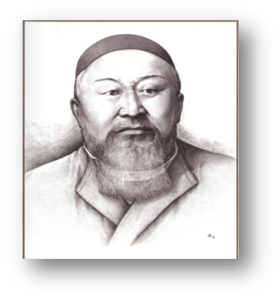 Utepbaev devoted his works to the image of Abai. The main theme of Nurlan Utepbaev (a graphic artist, a member of the Union of Artists (1997), a professor, a member of the Union of Designers of the Republic of Kazakhstan (2004)) is an aul, ordinary people of the native land. For several years N. Utepbaev lived in the village of Kaska-Bulak, got acquainted with the native places of the great poet Abai, his family and friends, studied literary and historical materials. As a result, the artist created a series of Abai’s portraits and Abai’s relatives .
Utepbaev devoted his works to the image of Abai. The main theme of Nurlan Utepbaev (a graphic artist, a member of the Union of Artists (1997), a professor, a member of the Union of Designers of the Republic of Kazakhstan (2004)) is an aul, ordinary people of the native land. For several years N. Utepbaev lived in the village of Kaska-Bulak, got acquainted with the native places of the great poet Abai, his family and friends, studied literary and historical materials. As a result, the artist created a series of Abai’s portraits and Abai’s relatives .
 Aisha Galimbayeva addresses to the theme of Abai. After graduating from the All-Union State Institute of Cinematography she created sketches of scenery and costumes for the script “Songs of Abai” by M. Auezov (1949). To study the materials for the film, Galimbaeva worked in museums, visited the places of Abai, made dozens of sketches. In the sixties, she created an interesting cycle of works on the subjects of the film “Songs of Abai”: “The Court of Biys”, “Wedding Evening”, “Toy”, “Aitys”, “Meeting” and others.
Aisha Galimbayeva addresses to the theme of Abai. After graduating from the All-Union State Institute of Cinematography she created sketches of scenery and costumes for the script “Songs of Abai” by M. Auezov (1949). To study the materials for the film, Galimbaeva worked in museums, visited the places of Abai, made dozens of sketches. In the sixties, she created an interesting cycle of works on the subjects of the film “Songs of Abai”: “The Court of Biys”, “Wedding Evening”, “Toy”, “Aitys”, “Meeting” and others.
In the works of painters of Kazakhstan, Abai appears as a poet-thinker, philosopher, humanist-enlightener, living the tragedies and hopes of Kazakh people.
A new rise in the studying of the “theme of Abai” arises at present. The Abai’s multifaceted image allows to artists to study of the depths and heights of his human destiny.
Used literature
- Abai. Encyclopedia / Chief Editor R.N. Nұrgaliev.-Almaty, “Kazakh Encyclopedia ”, Publishing house“Atamұra” , 1995.-720 p.
- Baranov K. Masters of Fine Arts of Kazakhstan: Album / Completed by R.A. Amirov.-Alma-Ata, Oner ( Art), 1986.-136p.
- Barmankulov B. History of the Arts of Kazakhstan in 3 volumes. Vol. 3. Painting. Graphics. Sculpture.-Almaty, Oner, 2011.-192 p.
- Beisenbaev M. About Abai’s drawings // Abai.-1993.-29-31p.
- Vandrovskaya E. Abylkhan Kasteev.-M .: Soviet artist.-1955.-63 p.
- Vandrovskaya E. Kanafiya Temir-Bulatovich Telzhanov.-M.: Soviet artist, 1973.-80 p.
- Kalymbaeva A. Kazakhstan decorative arts. Album ( Adaptation of the text by I.A. Rybakova) .- Almaty: Oner, 1981.-108 p.
- Isabaev I. …. I devoted my soul to my people. -Almaty, Asyl Soz Printing house, 2016.-240 p.
- The history of Kazakh art. V.3: The art of Kazakhstan of modern and modern times.-Almaty, Arda, 2013.-864 p.
- Kayrambaev J. Album.-Almaty, Oner.-2008.-160 p.
- Kopbosinova R. Young artists of Kazakhstan. Painting, graphics, sculpture.-Alma-Ata, Zhazushi.-1972.-47p.
- Masters of fine art of Kazakhstan. 4-issue / Ergalieva R.A., Truspekova H.H., Sharipova D.S. , Almaty, Zhibek Zholy Publishing House, 2009.-200 p.
- Masters of fine art of Kazakhstan. 3-issue / Ergalieva R.A., Truspekova H.H., Kargabekova R.I. – Almaty, 2004.-172 p.
- Otepbaev N. Philosophy of Art. Semey, 1918.-128 p.
- Rybakova I.A. Nagim-bek Nurmukhammedov.-M.: Soviet artist, 1977.-94 p.